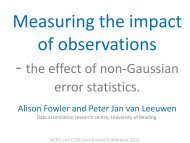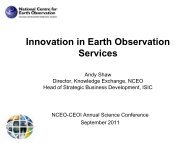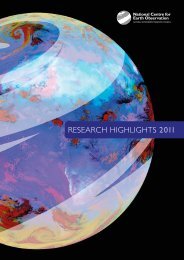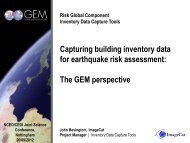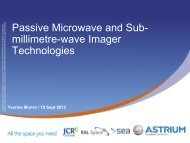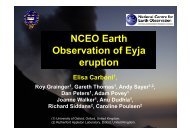The value of EO for constructing indicators of marine ecosystem status
The value of EO for constructing indicators of marine ecosystem status
The value of EO for constructing indicators of marine ecosystem status
You also want an ePaper? Increase the reach of your titles
YUMPU automatically turns print PDFs into web optimized ePapers that Google loves.
Monitoring the ocean <strong>ecosystem</strong> by<br />
Remote Sensing<br />
Trevor Platt and Shubha Sathyendranath<br />
Plymouth Marine Laboratory, UK
Context: Stewardship <strong>of</strong> the Ocean<br />
• Global consensus (UN Declaration): Management should have<br />
<strong>ecosystem</strong> basis, system integrity should be maintained.<br />
Preserve <strong>ecosystem</strong> attributes such as health, vigour, resilience,<br />
• But these are difficult to quantify.<br />
• Instead, develop suite <strong>of</strong> Ecological Indicators: objective metrics<br />
<strong>for</strong> the pelagic <strong>ecosystem</strong> that can be applied serially, in<br />
operational mode, to detect changes.
How to Quantify Ecosystem Integrity?<br />
• Concepts such as the health, vigour and resilience <strong>of</strong> the<br />
<strong>ecosystem</strong> are subjective and difficult to quantify<br />
• Instead, develop suite <strong>of</strong> Ecological Indicators as an aid<br />
to <strong>ecosystem</strong>-based management<br />
• <strong>The</strong>y are objective metrics <strong>for</strong> the pelagic <strong>ecosystem</strong> that<br />
can be applied serially, in operational mode, to detect<br />
changes that may occur in response to environmental<br />
perturbation
Ideal Characteristics <strong>of</strong> Pelagic Indicators<br />
• Represent a well-understood and widely-accepted<br />
<strong>ecosystem</strong> property<br />
• Quantifiable unambiguously in standard units<br />
• Measurable rapidly at low incremental cost<br />
• Repeat frequency compatible with intrinsic time scale<br />
<strong>of</strong> properties under study<br />
• Measurable at a variety <strong>of</strong> scales<br />
• Possibility to create long (multi-decadal) time series<br />
Platt and Sathyendranath, 2008
Remote sensing <strong>for</strong> Operational Metrics<br />
• Meets requirements <strong>of</strong> speed, resolution, repeat<br />
frequency and cost-effectiveness<br />
• Autotrophic biomass important <strong>ecosystem</strong> property<br />
• Primary production fields can also be generated<br />
• SST and chlorophyll obtainable at same resolution<br />
• Can construct time series: seasonal dynamics can be<br />
quantified objectively<br />
• Allows interannual comparisons<br />
Platt and Sathyendranath 2008
Construction <strong>of</strong> time series possible<br />
at any chosen scale <strong>of</strong> spatial averaging: provides the raw<br />
material <strong>for</strong> construction <strong>of</strong> <strong>indicators</strong><br />
Seasonal signal is key<br />
feature <strong>of</strong> the time series:<br />
Spring bloom is dominant<br />
event in seasonal cycle.<br />
Inter-annual fluctuations in<br />
phase are important<br />
(Platt, Sathyendranath &<br />
Fuentes-Yaco, 2007).
Some Ecological Indicators from Remote Sensing: Compact<br />
description <strong>of</strong> pelagic <strong>ecosystem</strong><br />
Initiation <strong>of</strong> spring bloom<br />
Amplitude <strong>of</strong> spring bloom<br />
Timing <strong>of</strong> spring maximum Duration <strong>of</strong> spring bloom<br />
Total production in spring bloom Annual phytoplankton production<br />
Initial slope, light-saturation curve Assimilation number<br />
Particulate organic carbon Phytoplankton carbon<br />
Carbon-to-chlorophyll ratio Phytoplankton growth rate<br />
Phytoplankton loss rate Integrated phytoplankton loss<br />
Spatial variance in biomass field<br />
Spatial variance in production field<br />
Phytoplankton functional types<br />
Biogeochemical provinces<br />
Pelagic <strong>ecosystem</strong> can be represented as a time-dependent<br />
vector whose elements are chosen from list <strong>of</strong> ecological<br />
<strong>indicators</strong>. Choice <strong>of</strong> elements depends on the particular<br />
applications envisaged. A concise description <strong>of</strong> <strong>ecosystem</strong>.<br />
Platt and Sathyendranath, 2008
Fisheries & Other Applications <strong>of</strong> <strong>EO</strong> Indicators include:<br />
• Harvest Fisheries<br />
- economies <strong>of</strong> fuel and time<br />
• Fisheries Management<br />
- intelligence on <strong>ecosystem</strong> fluctuations<br />
and effect on future states <strong>of</strong> exploited stocks<br />
• Aquaculture Industry<br />
- carrying capacity, harmful algal blooms<br />
• Protection <strong>of</strong> Species at Risk<br />
- exclusion zones and reduction <strong>of</strong> by-catch<br />
• Marine Protected Areas & Vulnerable Marine Ecosystems<br />
- delineation <strong>of</strong> these<br />
• Ecosystem Health and Ecosystem Services<br />
- monitoring health, evaluating services<br />
• High Seas Governance<br />
- international governance strategy, <strong>ecosystem</strong><br />
delineation, straddling stocks
What is the UK competence in this area?<br />
International leader on scientific side (theory and demonstration<br />
projects, especially in fisheries)<br />
International leader on scientific side (CoastColour; CCI Ocean<br />
Colour, SST and emerging synergies; IOCCG; GreenSEAS; G<strong>EO</strong><br />
Oceans & Society: the Blue Planet)<br />
International leader on pre-operational side (MyOCEAN)<br />
NERC National capability in ocean colour and SST (N<strong>EO</strong>DAAS)<br />
Marine component <strong>of</strong> NC<strong>EO</strong> Carbon <strong>The</strong>me
What is the expected future?<br />
Demand <strong>for</strong> in<strong>for</strong>mation on ocean <strong>ecosystem</strong> can only<br />
increase, in UK and abroad, <strong>for</strong> national, European<br />
and international reasons<br />
Biodiversity is becoming a household word. Potential<br />
<strong>of</strong> remote sensing <strong>for</strong> <strong>marine</strong> biodiversity is yet to be<br />
fully exploited<br />
<strong>The</strong>re is a vacant niche to be occupied



